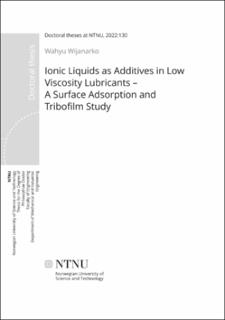| dc.description.abstract | The trend in lubrication nowadays is towards low viscosity lubricants. Low viscosity lubricants flow more easily, increasing the lubricant volume circulation thus improving the cooling performance and cleaning ability of the lubricants. In addition, low viscosity lubricants reduce the viscous drag thus lowering the frictional energy losses and increasing the efficiency of components. Moreover, low viscosity lubricants are the best candidates for lubricating electric vehicles (EVs) due to the presence of more torque transfer components (transmission) than in internal combustion engine vehicles. Therefore, the application of low viscosity lubricants will increase the performance and extend the lifetime of EVs. While low viscosity lubricants offer many advantages, there are also challenges that go with them. Firstly, there will be more pair contact at the beginning of the operation. Secondly, the low viscosity of the lubricant will result in a higher friction at the boundary and mixed lubrication regimes. Lastly, the low viscosity the lubricant will result in longer running-in times at the boundary and mixed lubrication regimes. To overcome these challenges, one of the proposed strategies is developing multifunctional additives which simultaneously will work as anti-wear and friction reduction at the same time. To tackle these issues, this Ph.D. thesis investigates the potential use of ionic liquids (ILs) as additives in low viscosity lubricants.
Firstly, preliminary studies of six ILs with different anion, cation, and alkyl chain length as additives were performed. The selected ILs were 1,3-dimethylimidazolium dimethylphosphate (IM), (2-hydroxyethyl) trimethylammonium dimethylphosphate (AM), tributylmethylphosphonium dimethylphosphate (PP), 1-butyl-1-methylpyrrolidinium tris(pentafluoroethyl) trifluorophosphate (BMP), trihexyltetradecylphosphonium bis(2,4,4-trimethylpentyl)phosphinate (PB), and trihexyltetradecylphosphonium decanoate (PC). The ILs were mixed individually in low viscosity lubricants (polar and non-polar), i.e., four water-glycol mixtures (as polar base lubricant) and two polyalphaolefins (as non-polar base lubricant). The water-glycol base lubricants were watermonoethylene glycol (WMEG), water-diethylene glycol (WDEG), water-monopropylene glycol (WMPG), and water-dipropylene glycol (WDPG). The polyalphaolefin base lubricants were polyalphaolefin 2 cSt and 8 cSt. All lubricants combinations were analyzed in terms of mixture stability and solubility and tribological performances of the ionic liquids as lubricant additives. The results showed that long alkyl chain ILs, PB and PC, resulted in high turbidity numbers and poor stability. The tribological performances of short alkyl chain ILs, IM, AM, PP, and BMP, showed no improvement in wear protection. In the case of friction, only WDPG–ILs and PAO8-IL combinations brought lower friction evolution than the corresponding base lubricant.
Secondly, the effect of the additives’ concentration was investigated in terms of tribological performances (friction and wear). Five different concentrations of ILs were studied 0.25, 0.5, 1, 2, and 4 wt.%. The results obtained from preliminary studies led to the selection of short alkyl chain ILs (IM, AM, PP, and BMP) and WDPG and PAO8 as the base lubricants. For simplicity, WDPG and PAO8 will be called only WG and PAO, respectively. A comprehensive analysis of the influence of ILs and their concentration on friction and wear were conducted using a Two-way ANOVA. The results showed that an increase in the ILs’ concentration raised both the coefficient of friction (COF) and specific wear rate (SWR) for WG lubricants however, it reduced COF and SWR for PAO lubricants depending on the IL type and concentration. From this study, PP and BMP were selected for further studies with the concentration of 1 wt.%.
Thirdly, the adsorption behavior of the selected ILs, PP and BMP, were investigated in both polar (WG) and non-polar (PAO) media. The adsorption behavior of the ILs was compared with a wellknown organic friction modifier additive, i.e., carboxylic acid (dodecanoic acid, C12). The adsorption studies were performed using a quartz crystal microbalance with dissipation (QCM-D). The adsorption behaviors of the additives were investigated on two surfaces, namely iron and stainless steel surfaces by using iron (Fe)-coated sensor and stainless steel (SS)-coated sensor. The results showed that PP and BMP formed thicker multi-layer structures in non-polar media compared to polar media. In the case of C12, the results showed that C12 formed a thicker, more viscous, and more rigid adsorbed layer in polar media than in non-polar media. For WG lubricants, there was no significant difference in the adsorption behavior of the additives between Fe and SS coated sensors. However, for PAO lubricants, only PP and BMP showed higher adsorption kinetics and initially adsorbed layer on the SS surface than the Fe surface, whereas C12 showed no significant differences in the adsorption behaviour.
Lastly, the tribological performances of PP and BMP as additives in polar (WG) and non-polar (PAO) base lubricants were investigated on two types of steel, namely AISI 52100 bearing steel and AISI 316L stainless steel. The tribological performances of ILs were compared with C12. Intensive surface analyses using several advanced techniques were performed, such as scanning electron microscopy equipped with focused ion beam (FIB-SEM), scanning-transmission electron microscopy equipped with X-ray energy dispersive spectroscopy (STEM-EDS), and X-ray photoelectron spectroscopy (XPS). The results from adsorption studies by QCM-D were used to correlate the adsorption behavior with the tribological performance. In the case of the polar lubricants, the tribological performance of ILs was controlled by the presence of thick tribofilms which lowered the wear yet increasing the friction for AISI 52100 steel. On the other hand, thick tribofilms could not be formed due to the tribocorrosion process taking place on AISI 316L steel, thus the tribological performance of the ILs was controlled by the tribocorrosion process. In the case of non-polar lubricants, the tribological performance of the ILs was controlled by the presence of thick tribofilms which increased both wear and friction for AISI 52100 steel. In the case of AISI 316L, the tribological performance of the ILs was controlled by both tribofilm durability and the properties of the adsorbed layer. | en_US |
